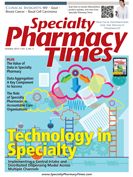Publication
Article
Specialty Pharmacy Times
Breast Cancer
Author(s):
New research on breast cancer screening and mammography are presented, along with recent findings regarding the efficacy of axillary lymph node removal.
New research on breast cancer screening and mammography are presented, along with recent findings regarding the efficacy of axillary lymph node removal.
Spread of Breast Cancer Missed with Some Screens
In a new analysis presented at the 2012 Breast Cancer Symposium, researchers have concluded that certain screening methods may not be beneficial and are often unnecessary in determining if breast cancer has spread.
The analysis, conducted by physicians from Lenox Hill Hospital in New York, combined data from 8 studies and found very low detection rates of bone scans, liver ultrasounds, and chest x-rays in patients with stage I or stage II disease. These tests are often used to test spread of breast cancer because breast cancer can spread to the bones, liver, and lungs.
The detection rates were very low for stage I and II cancers, at 2.43% for bone scans, 0.82% for liver ultrasounds, and 0.51% for chest x-rays. The physicians recommend not using these tests, not only because they do not provide a clear picture of metastases, but because they also may cause unnecessary further testing and more undue stress for cancer patients and their families. Moreover, the tests, which come with further follow-up, can be costly.
When surveying for metastasis, the physicians recommend the use of CT scans, MRIs, and PET scans over bone scans, liver ultrasounds, and chest x-rays, and only for patients with stage III cancer. Further research needs to be done comparing these scans to the ones used in the present analysis to confirm superiority in stage III disease.
Axillary Lymph Node Removal May Prolong Survival in High-Risk Women
A study presented at the 2012 Breast Cancer Symposium suggests that patients at high risk for residual nodal disease may benefit from axillary node removal. The study was decided upon only after a previous study had shown that axillary lymph node removal was not beneficial in patients with only 1 or 2 positive sentinel lymph nodes. That study was criticized for being too generalized and for not enrolling patients at higher risk.
For the present study, which was designed by researchers from the Harvard Radiation Oncology Program in Boston, patients were split into 2 risk groups based on residual nodal involvement following removal of the sentinel lymph node. These 2 risk groups were defined as low risk (risk for residual nodal involvement of 0% to 30%) and high risk (risk for residual nodal involvement of 30% to 60%). All patients had stage II breast cancer.
Overall survival and quality-adjusted life expectancy were assessed. What the researchers found was a difference in quality-adjusted life expectancy between high-risk women treated with radiation alone and those treated with radiation and node removal. Overall survival, although the same between both radiation alone and radiation-plus-node-removal groups at 5 years, was lower in the radiation-alone group than the radiation-plus-node-removal group. There were no differences in the low-risk group.
The study demonstrates the importance of carefully planning treatment strategies based on risk assessment. Identifying patients with high-risk residual nodal disease may improve outcomes.
Benefits of Mammography Outweigh Risks
Increased use of mammography is causing the mortality rate of breast cancer to decrease, a new study suggests.
The study, a comprehensive review published in the Journal of Medical Screening in September 2012 by the European Screening Network Working Group, analyzed data from 12 million women collected from 26 screening programs in 18 countries from 2001 to 2007. It measured the total number of deaths that were prevented in a period of 30 years, from the ages of 50 to 79.
The authors discovered that European population-based mammography programs are contributing to the reduction in breast cancer mortality in the European Union, and that the number of breast cancer deaths avoided by screening exceeds the estimated number of cases of overdiagnosis. In fact, the authors write, for every 1 case of breast cancer overdiagnosed, 2 lives would be saved with mammography. The study is in contrast to another study that showed that many patients are overdiagnosed and treated unnecessarily.
Mammography is an excellent screening program for breast cancer, the authors write, and a significant step that many women can take in making advanced and life-threatening breast cancer a preventable outcome.
About the Author
Michael C. Wisotsky, PharmD, RPh, practices in Shrewsbury, New Jersey.







